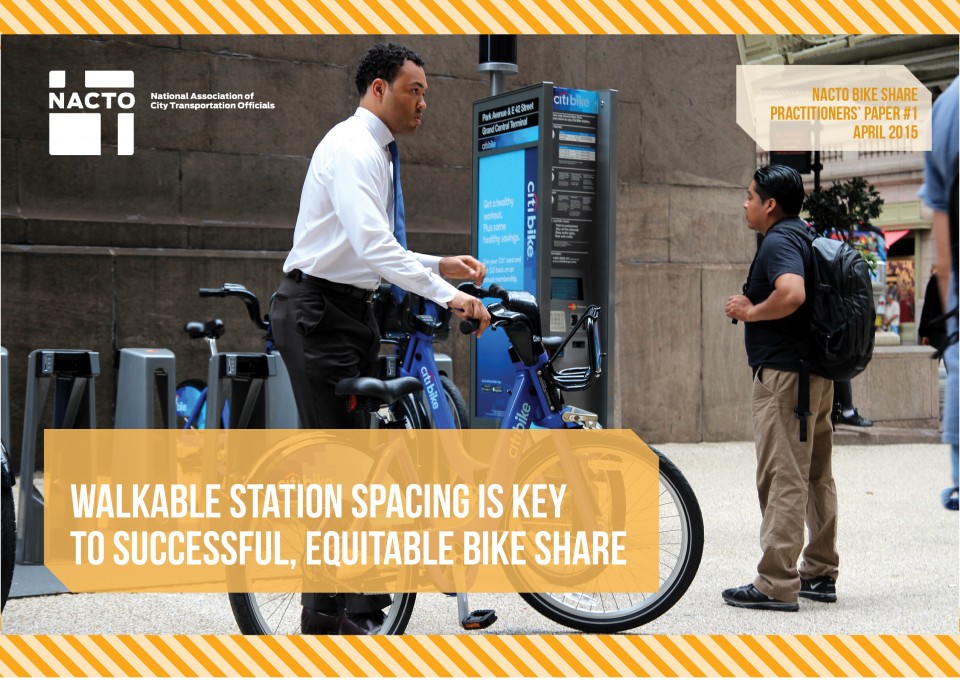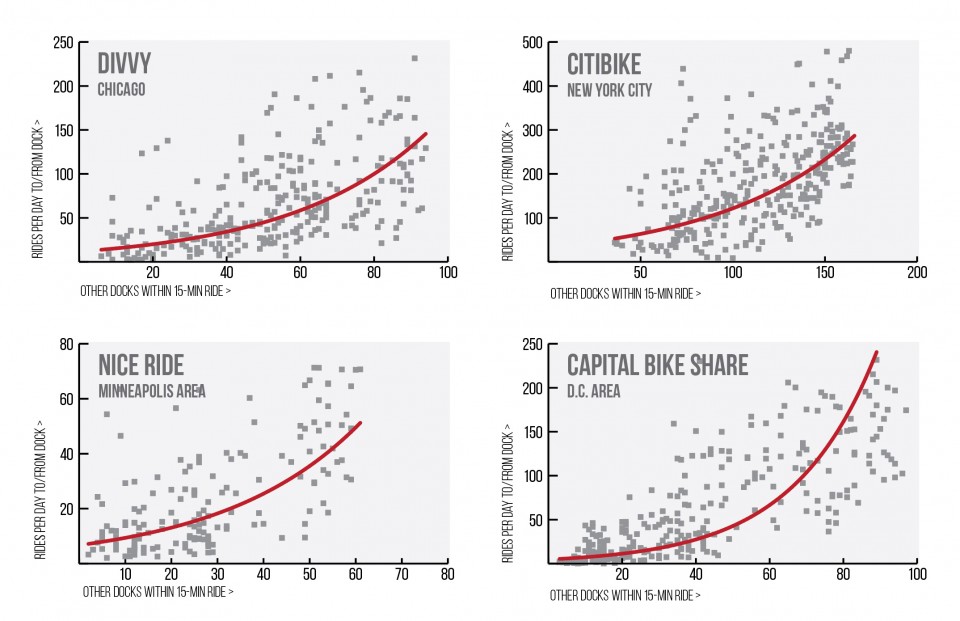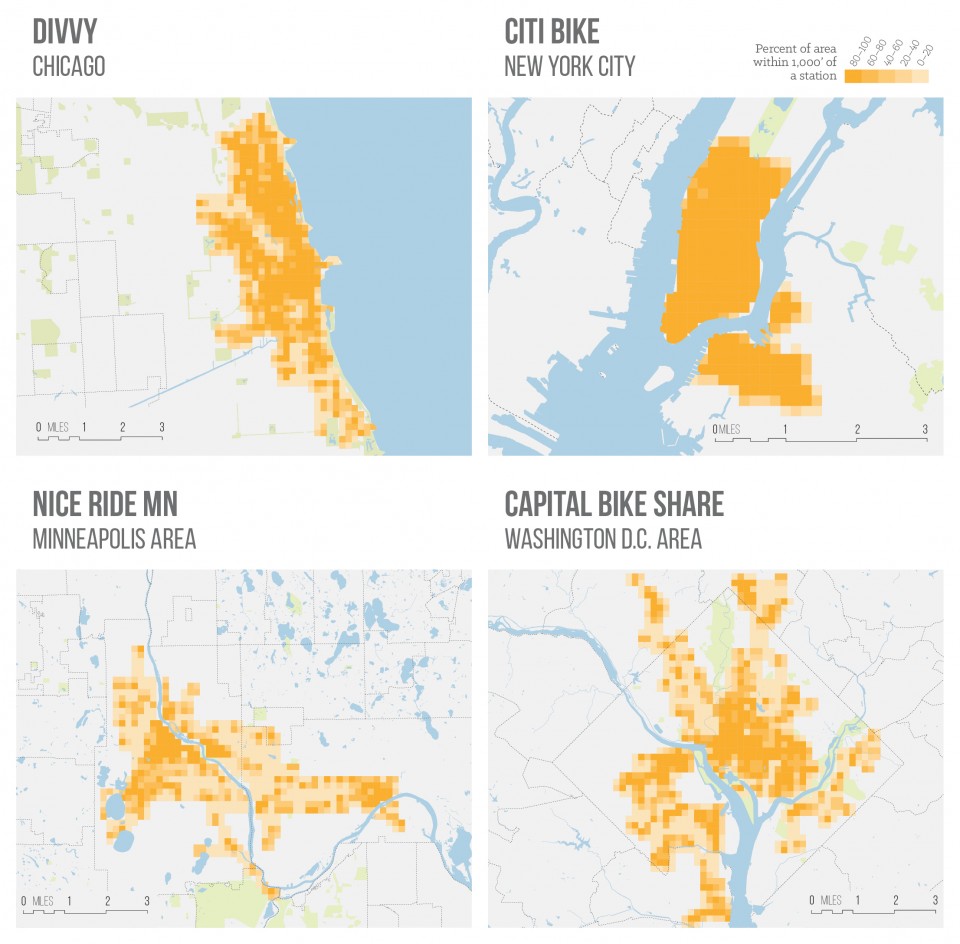Cities can improve ridership, equity by increasing station density to 28 stations per square mile
NACTO introduces “Practitioners’ Paper” series to highlight best practices for cities aiming to address equity issues while introducing or expanding their bike share systems

NEW YORK (April 28, 2015) — Bike share use increases exponentially with station density, according to a new NACTO analysis of U.S. bike share system data, released today. Systems that are designed with stations a five minute walk apart provide more convenient, reliable service and are used much more frequently than systems with more far-flung stations. To increase ridership among low-income populations, bike share systems must be designed to offer a meaningful transportation option. As cities seek to build successful, equitable bike share systems, NACTO finds that high station density – approximately 28 stations per square mile – and even station spacing is key.
NACTO’s Walkable Station Spacing is Key to Successful, Equitable Bike Share makes the connection between station density, service quality and equity, and provides a data-driven analysis for system operators looking to expand the reach and utility of their bike share systems. Looking at ridership data from a variety of U.S. bike share systems, NACTO finds that the utility of a bike share system, as well as ridership, increase exponentially when stations are closer together. Data analyzed from bike share member surveys clearly shows that convenience is the reason why people use bike share and station placement must be guided by the distance people are willing to walk to find a bike. Equitable bike share requires close, even station spacing – a station every 1,000 feet – in order to create a convenient network of stations that allows people to make the trips they want to make.

In an effort to serve a greater geographic area, however, many cities have lower station density and fewer stations overall in the low-income neighborhoods that their bike share systems serve. NACTO’s research shows that the “one in each neighborhood” station siting model does not advance equity, as it reduces service quality and ridership and makes bike share a less convenient transportation choice, especially for low-income residents. Cities can increase bike share use by ensuring that all neighborhoods in their program areas, regardless of income, are served by a large number of bike share stations, evenly spaced a short walking distance (no more than 5 minutes) apart.
To help cities identify locations where infill stations are needed, NACTO’s Bike Share Program has developed a GIS model that measures system convenience. Cities interested in using the model can contact NACTO. NACTO’s research also highlights the importance of protected bike lanes in making bike share a real option for people of all cycling abilities.

“As bike share systems continue to proliferate around the U.S., sharing information on how to design successful systems is crucial,” said Ed Reiskin, President of NACTO and Director of Transportation of the San Francisco Municipal Transportation Agency (SFMTA). “NACTO’s new Bike Share Program provides a valuable resource for our 39 member cities and anyone looking to introduce or expand a bike share program.”
“All across the country, cities and their partners have proved that bike share works,” said Bill Dossett, Executive Director of NiceRide Minnesota. “As the bike share industry continues to grow, NACTO’s research gives operators the tools to make the case for continued investment in bike share systems that serve as real transportation options for everyone.”
“Citi Bike has been a resounding success, with New York City residents and visitors taking an unprecedented 16 million trips in under two years,” said NYC Department of Transportation Commissioner Polly Trottenberg. “As NACTO’s research suggests, creating a dense network of stations — always separated by walkable distances — has been key to Citi Bike’s popularity. This guiding principle is one we will continue to follow as the network continues to grow in the coming years.”
Walkable Station Spacing is Key to Successful, Equitable Bike Share is the first in NACTO’s Practitioners’ Papers series which identify best practices for cities introducing or expanding bike share systems. The papers specifically address strategies to increase the number of low-income people who use and benefit from bike share systems.
The NACTO Bike Share Program is led by Kate Fillin-Yeh, the former Director of NYC DOT’s Bike Share Program. At NYC DOT Kate was responsible for the system planning, outreach and implementation of New York’s Citi Bike system. Kate is also the author of New York City’s 2009 bike share feasibility study, Bike Share Opportunities in New York City.
NACTO is a member of the Better Bike Share Partnership, a JPB funded collaboration between The City of Philadelphia, Bicycle Coalition of Greater Philadelphia, NACTO, and PeopleForBikes, to increase access to and use of bike share in underserved communities.
For more information about NACTO’s Bike Share Program, or to inquire about using NACTO’s bike share system convenience model, contact Kate Fillin-Yeh, Bike Share Program Director, at [email protected].